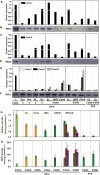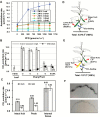The complex character of photosynthesis in cucumber fruit
- PMID: 28369547
- PMCID: PMC5441898
- DOI: 10.1093/jxb/erx034
The complex character of photosynthesis in cucumber fruit
Abstract
The surface area of a mature green cucumber (Cucumis sativa L.) fruit is comparable with that of a functional leaf, but the characteristics of fruit photosynthesis and its contribution to growth are poorly understood. Here, the photosynthetic properties of two genotypes of cucumber (dark green and light green fruits) were studied using a combination of electron microscopy, immunogold enzyme localization, chlorophyll fluorescence imaging, isotope tracer, and fruit darkening techniques. Chlorophyll content of the exocarp is similar to that of leaves, but there are no distinctive palisade and spongy tissues. The efficiency of PSII is similar to that in leaves, but with lower non-photochemical quenching (NPQ). Ribulose-1,5-bisphosphate carboxylase/oxygenase (Rubisco) is found mainly in the exocarp, while phosphoenolpyruvate carboxylase (PEPC) is primarily localized to vascular bundles and placenta tissue. Rubisco and PEPC expression at both transcriptional and translational levels increases concurrently during fruit growth. The contribution of fruit photosynthesis in exocarp to its own C accumulation is 9.4%, while ~88% of respiratory CO2 in fruit was captured and re-fixed. Photosynthesis by cucumber fruits, through direct fixation of atmospheric CO2 and recapture of respired CO2, as verified by 14CO2 uptake and gas exchange, makes an important contribution to fruit growth.
Keywords: Chloroplast; PEPC (phosphoenolpyruvate carboxylase); Rubisco (ribulose-1,5-bisphosphate carboxylase/oxygenase).; cucumber; fruit photosynthesis; respiration.
© The Author 2017. Published by Oxford University Press on behalf of the Society for Experimental Biology.
Figures








Similar articles
-
Photosynthesis-related characteristics of the midrib and the interveinal lamina in leaves of the C3-CAM intermediate plant Mesembryanthemum crystallinum.Ann Bot. 2016 Jun;117(7):1141-51. doi: 10.1093/aob/mcw049. Epub 2016 Apr 18. Ann Bot. 2016. PMID: 27091507 Free PMC article.
-
Brassinosteroids promote photosynthesis and growth by enhancing activation of Rubisco and expression of photosynthetic genes in Cucumis sativus.Planta. 2009 Nov;230(6):1185-96. doi: 10.1007/s00425-009-1016-1. Epub 2009 Sep 17. Planta. 2009. PMID: 19760261
-
Overexpression of the rubisco activase gene improves growth and low temperature and weak light tolerance in Cucumis sativus.Physiol Plant. 2017 Oct;161(2):224-234. doi: 10.1111/ppl.12587. Epub 2017 Jun 28. Physiol Plant. 2017. PMID: 28543370
-
Manipulating PEPC levels in plants.J Exp Bot. 2002 Sep;53(376):1837-45. doi: 10.1093/jxb/erf061. J Exp Bot. 2002. PMID: 12177121 Review.
-
C(4) photosynthesis: principles of CO(2) concentration and prospects for its introduction into C(3) plants.J Exp Bot. 2002 Apr;53(369):581-90. doi: 10.1093/jexbot/53.369.581. J Exp Bot. 2002. PMID: 11886878 Review.
Cited by
-
Comparative transcriptome analysis identifies genes associated with chlorophyll levels and reveals photosynthesis in green flesh of radish taproot.PLoS One. 2021 May 27;16(5):e0252031. doi: 10.1371/journal.pone.0252031. eCollection 2021. PLoS One. 2021. PMID: 34043661 Free PMC article.
-
Impact of Foliar Application of ZnO and Fe3O4 Nanoparticles on Seed Yield and Physio-Biochemical Parameters of Cucumber (Cucumis sativus L.) Seed under Open Field and Protected Environment vis a vis during Seed Germination.Plants (Basel). 2022 Nov 23;11(23):3211. doi: 10.3390/plants11233211. Plants (Basel). 2022. PMID: 36501251 Free PMC article.
-
Cucumber malate decarboxylase, CsNADP-ME2, functions in the balance of carbon and amino acid metabolism in fruit.Hortic Res. 2023 Oct 25;10(12):uhad216. doi: 10.1093/hr/uhad216. eCollection 2023 Dec. Hortic Res. 2023. PMID: 38077499 Free PMC article.
-
Genetic Engineering for Global Food Security: Photosynthesis and Biofortification.Plants (Basel). 2019 Dec 9;8(12):586. doi: 10.3390/plants8120586. Plants (Basel). 2019. PMID: 31835394 Free PMC article. Review.
-
Comprehensive Characterization of Fruit Volatiles and Nutritional Quality of Three Cucumber (Cucumis sativus L.) Genotypes from Different Geographic Groups after Bagging Treatment.Foods. 2020 Mar 5;9(3):294. doi: 10.3390/foods9030294. Foods. 2020. PMID: 32150913 Free PMC article.
References
-
- Aschan G, Pfanz H. 2003. Non-foliar photosynthesis—a strategy of additional carbon acquisition. Flora 198, 81–97.
-
- Baker NR. 2008. Chlorophyll fluorescence: a probe of photosynthesis in vivo. Annual Review of Plant Biology 59, 89–113. - PubMed
-
- Blanke MM, Lenz F. 1989. Fruit photosynthesis. Plant, Cell and Environment 12, 31–46.
-
- Bradford MM. 1976. A rapid and sensitive method for the quantitation of microgram quantities of protein utilizing the principle of protein–dye binding. Analytical Biochemistry 72, 248–254. - PubMed
Publication types
MeSH terms
Substances
LinkOut - more resources
Full Text Sources
Other Literature Sources
Molecular Biology Databases

